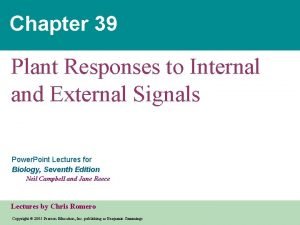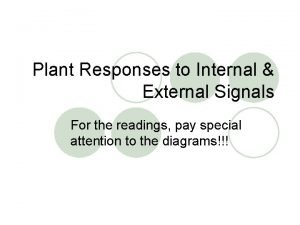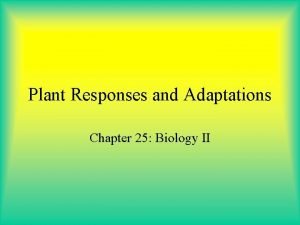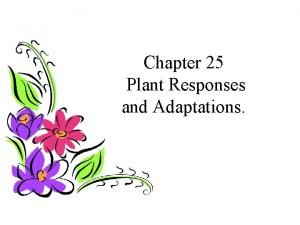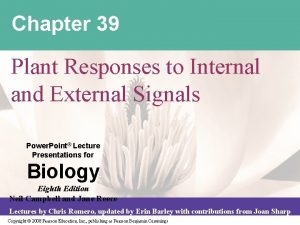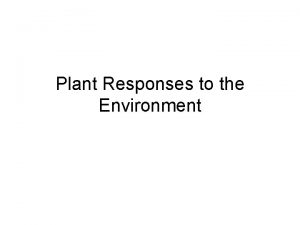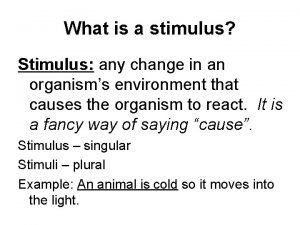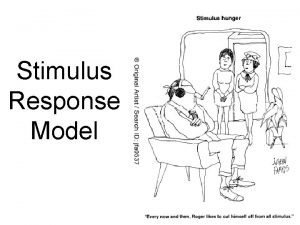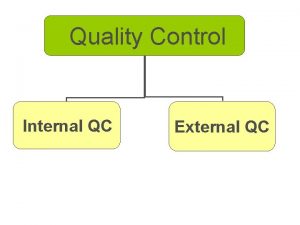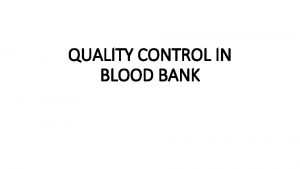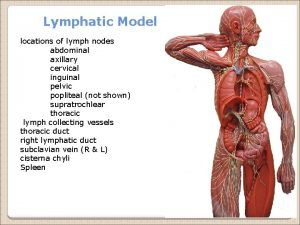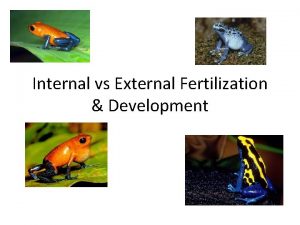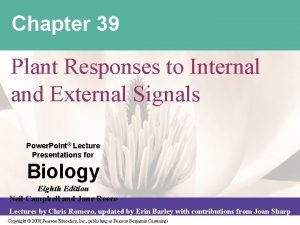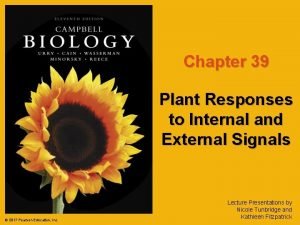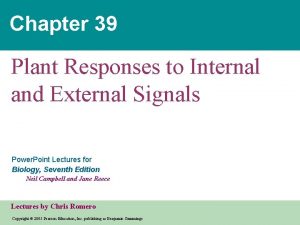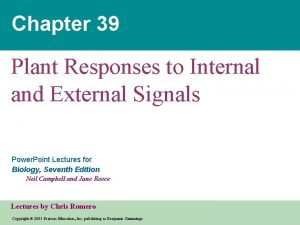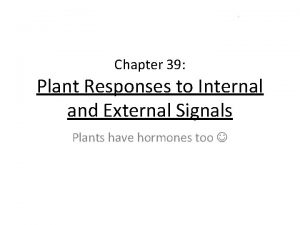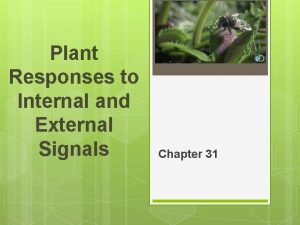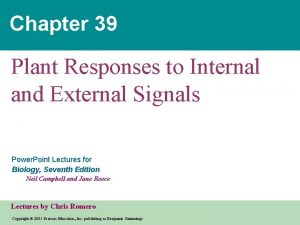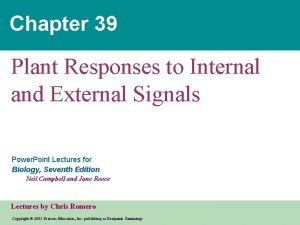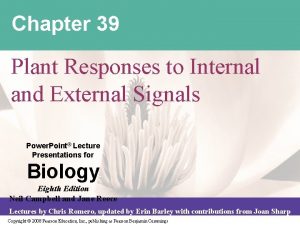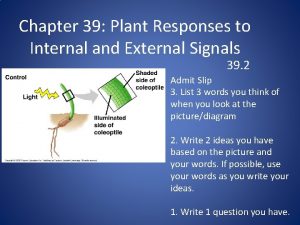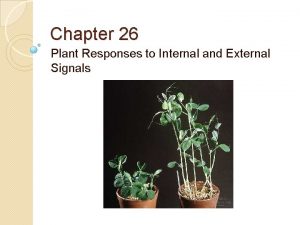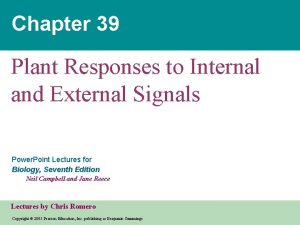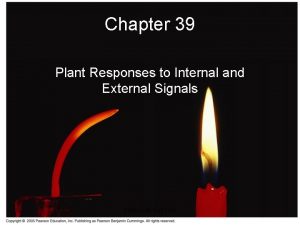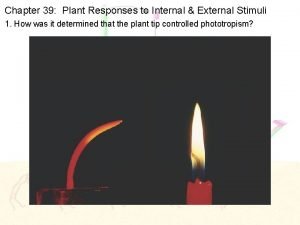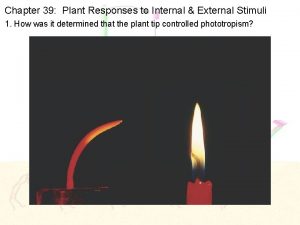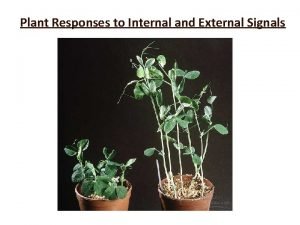Chapter 39 Plant Responses to Internal and External
























- Slides: 24

Chapter 39 Plant Responses to Internal and External Signals Power. Point® Lecture Presentations for Biology Eighth Edition Neil Campbell and Jane Reece Lectures by Chris Romero, updated by Erin Barley with contributions from Joan Sharp Copyright © 2008 Pearson Education, Inc. , publishing as Pearson Benjamin Cummings

Concept 39. 1: Signal transduction pathways link signal reception to response • Like animals, plants have cellular receptors that detect changes in their environment and signaling pathways that mediate a response Copyright © 2008 Pearson Education, Inc. , publishing as Pearson Benjamin Cummings

• For example: A potato left growing in darkness produces shoots that look unhealthy and lacks elongated roots • These are morphological adaptations for growing in darkness, collectively called etiolation • After exposure to light, a potato undergoes changes called de-etiolation, in which shoots and roots grow normally Copyright © 2008 Pearson Education, Inc. , publishing as Pearson Benjamin Cummings

Fig. 39 -2 (a) Before exposure to light (b) After a week’s exposure to natural daylight

Fig. 39 -3 CELL WALL 1 Reception CYTOPLASM 2 Transduction Relay proteins and second messengers Receptor Hormone or environmental stimulus Plasma membrane 3 Response Activation of cellular responses

Fig. 39 -4 -3 1 Reception 2 Transduction 3 Response Transcription factor 1 CYTOPLASM Plasma membrane c. GMP Second messenger produced Specific protein kinase 1 activated NUCLEUS P Transcription factor 2 Phytochrome activated by light P Cell wall Specific protein kinase 2 activated Transcription Light Translation Ca 2+ channel opened Ca 2+ De-etiolation (greening) response proteins

Concept 39. 2: Plant hormones help coordinate growth, development, and responses to stimuli • Tropisms are often caused by hormones • Any response resulting in curvature of organs toward or away from a stimulus is called a tropism Copyright © 2008 Pearson Education, Inc. , publishing as Pearson Benjamin Cummings

• In the late 1800 s, Charles Darwin and his son Francis conducted experiments on phototropism, a plant’s response to light • They observed that a grass seedling could bend toward light only if the tip of the coleoptile was present • They postulated that a signal was transmitted from the tip to the elongating region Copyright © 2008 Pearson Education, Inc. , publishing as Pearson Benjamin Cummings

Fig. 39 -5 a RESULTS Shaded side of coleoptile Control Light Illuminated side of coleoptile

Fig. 39 -5 b RESULTS Darwin and Darwin: phototropic response only when tip is illuminated Light Tip removed Tip covered by opaque cap Tip covered by transparent cap Site of curvature covered by opaque shield

Fig. 39 -5 c RESULTS Boysen-Jensen: phototropic response when tip is separated by permeable barrier, but not with impermeable barrier Light Tip separated by gelatin (permeable) Tip separated by mica (impermeable)

Plant Hormones • Auxin is involved in root formation and branching • Cytokinins are so named because they stimulate cytokinesis (cell division) • Cytokinins, auxin, and other factors interact in the control of apical dominance. If the terminal bud is removed, plants become bushier Copyright © 2008 Pearson Education, Inc. , publishing as Pearson Benjamin Cummings

Plant Hormones • Gibberellins have a variety of effects, such as stem elongation, fruit growth, and seed germination Copyright © 2008 Pearson Education, Inc. , publishing as Pearson Benjamin Cummings

Plant Hormones • Abscisic acid (ABA) slows growth affecting seed dormancy and drought tolerance • Ethylene controls response to stresses – triggers the ripening process – Controls senescence - programmed death of plant cells or organs (leaf abscission) – induces the triple response, which allows a growing shoot to avoid obstacles Copyright © 2008 Pearson Education, Inc. , publishing as Pearson Benjamin Cummings

Concept 39. 3: Responses to light are critical for plant success • Effects of light on plant morphology are called photomorphogenesis • Plants detect not only presence of light but also its direction, intensity, and wavelength (color) • Many plant processes oscillate during the day – Ex: many legumes lower their leaves in the evening and raise them in the morning, even when kept under constant light or dark conditions (circadian rhythms) Copyright © 2008 Pearson Education, Inc. , publishing as Pearson Benjamin Cummings

Fig. 39 -20 Noon Midnight

Photoperiodism and Responses to Seasons • Photoperiodism is a physiological response to photoperiod (relative lengths of night and day, used to detect the time of year) – Lengthening or shortening of the amount of light/dark affects flowering Copyright © 2008 Pearson Education, Inc. , publishing as Pearson Benjamin Cummings

Fig. 39 -21 24 hours (a) Short-day (long-night) plant Light Critical dark period Flash of light Darkness (b) Long-day (short-night) plant Flash of light

Concept 39. 4: Plants respond to a wide variety of stimuli other than light • Response to gravity is known as gravitropism – statoliths Copyright © 2008 Pearson Education, Inc. , publishing as Pearson Benjamin Cummings

Mechanical Stimuli • Thigmomorphogenesis - changes in form that result from mechanical disturbance – Ex: Rubbing stems of young plants a couple of times daily results in plants that are shorter than controls Copyright © 2008 Pearson Education, Inc. , publishing as Pearson Benjamin Cummings

• Thigmotropism is growth in response to touch – vines and other climbing plants • Rapid leaf movements in response to mechanical stimulation are examples of transmission of action potentials Copyright © 2008 Pearson Education, Inc. , publishing as Pearson Benjamin Cummings

Concept 39. 5: Plants respond to attacks by herbivores and pathogens • Plants use defense systems to deter herbivory, prevent infection, and combat pathogens – Plants damaged by insects can release volatile chemicals to warn other plants of the same species Copyright © 2008 Pearson Education, Inc. , publishing as Pearson Benjamin Cummings

Defenses Against Pathogens • A plant’s first line of defense against infection is the epidermis and periderm • If a pathogen penetrates the dermal tissue, the second line of defense is a chemical attack that kills the pathogen and prevents its spread • This second defense system is enhanced by the inherited ability to recognize certain pathogens Copyright © 2008 Pearson Education, Inc. , publishing as Pearson Benjamin Cummings

The Hypersensitive Response • The hypersensitive response – Causes cell and tissue death near the infection site – Induces production of phytoalexins and PR proteins, which attack the pathogen – Stimulates changes in the cell wall that confine the pathogen Copyright © 2008 Pearson Education, Inc. , publishing as Pearson Benjamin Cummings
 Chapter 39 plant responses to internal and external signals
Chapter 39 plant responses to internal and external signals Plant responses to internal and external signals
Plant responses to internal and external signals Chapter 25 plant responses and adaptations answer key
Chapter 25 plant responses and adaptations answer key Chapter 25 plant responses and adaptations
Chapter 25 plant responses and adaptations Respond to
Respond to Plant hormones and responses
Plant hormones and responses Plant and animal responses
Plant and animal responses Interactions between ais and internal and external parties
Interactions between ais and internal and external parties Chapter 10 stress responses and stress management
Chapter 10 stress responses and stress management Five parts of flower
Five parts of flower Negative hydrotropism
Negative hydrotropism External users of accounting information are
External users of accounting information are Internal stakeholders examples
Internal stakeholders examples Stimulus response model temperature
Stimulus response model temperature Formal social control
Formal social control Internal and external factors of nationalism
Internal and external factors of nationalism Internal and external reliability
Internal and external reliability External and internal quality control
External and internal quality control Blood bank quality control
Blood bank quality control Stakeholders internal and external
Stakeholders internal and external Internal nares
Internal nares Iso 14001 risk and opportunities examples
Iso 14001 risk and opportunities examples Interrupt vs polling in microcontroller
Interrupt vs polling in microcontroller Internal vs external fertilization
Internal vs external fertilization External and internal hardware
External and internal hardware
